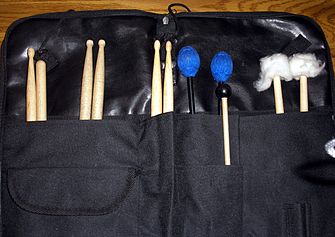- Percussion mallet
-
- This article is about the musical tool. For more meanings, see Drumstick (disambiguation).
A percussion mallet (or drum stick) is an object used to beat drums and other percussion instruments. Some specialized mallets are called beaters, drumsticks. Note: See Rute (music).
Contents
Drum sticks
The drum head is (usually) struck with the tip of the drum stick. Tips come in many shapes, such as acorn, barrel, oval and round. The tip is sometimes referred to as the bead. Traditionally, the tip is made of the same piece of wood as the rest of the stick, although there are drum sticks with a nylon tip conceived by Jonathan Pumphrey and Joe Calato in Niagara Falls, NY in 1958 and the newer acetal tip, conceived by Ken Drinan and Paul Kiersted in the 1970s. The acetal tip produces a brighter sound when playing cymbals and is less likely to splinter after sustained or violent use. However, it is prone to cracking or flying off.
Immediately below the tip is the shoulder of the stick, which tapers out. This section of the stick is prone to breaking after or during cymbal use or during rimshots if the sticks are held incorrectly, if the drum set is played incorrectly, or, most often, if the drummer plays hard. The rest of the stick is referred to as the shaft, with the butt at the opposite end to the tip.
Players use two sticks, employing either a matched grip, popularised by Ringo Starr in the 1960s or a traditional grip, popularised by Sanford A. Moeller from talks with American Civil War drummers/veterans. With either grip, players keep the balance point of the stick slightly beyond their hands.
Snare grips
See:
Major drum stick companies
- Agner Swissdrumsticks
- Super Sticks
- Vic Firth
- Malletech
- Vater
- Regal Tip
- Zildjian
- Pro-Mark
- Shaw
- Ruby Grip
- AHEAD
- Stunner
- Cooper-man
- Wincent
- Hiptrix Glowing Percussion
Mallets
A mallet comprises a head connected to a thin shaft. Unwrapped mallets, used on glockenspiel, xylophone and other instruments with keys made of durable material, have heads made of brass, rubber, nylon, acrylic, wood, or other hard materials; wrapped mallets, mostly used on marimba, vibraphone and other instruments with softer keys (though they can be used on more durable instruments as well), have heads of kelon, rubber, nylon, acrylic or other medium-hard materials wrapped in softer materials like yarn, cord or latex. Wrapped mallets are also the mallets of choice to play suspended cymbal, though drum set players typically simply use drum sticks instead. Mallet shafts are commonly made of rattan or birch.
Different mallets are used primarily to alter the timbre of the mallet instrument being played. Typically, softer or thicker mallets are used on an instrument's lower registers and harder, thinner mallets used on higher registers. Mallet choice is typically left up to the performer, though some compositions specify if a certain sound is desired by the composer.
Players frequently employ two mallets in a matched grip or four mallets in a four-mallet grip; however, use of up to six mallets is not uncommon. More than two mallets may be used even when no chords are called for by the composer so that the performer has a wider range of timbres from which to select or to facilitate performance of music that moves rapidly between high and low, and if hit properly can switch between the two pitches.
Types of mallets and drum sticks
Brushes
 Brushes play on a snare drum.
Brushes play on a snare drum.
Brushes are a set of bristles connected to a handle so that the bristles make a rounded fan shape. They are often used in Jazz, Swing music, or Blues music. The bristles can be made of metal or plastic; handles are commonly made of wood or aluminum, and are often coated with rubber. Some brushes are telescoping, so that the bristles can be pulled inside a hollow handle and the fan made by the bristles can be of variable length, width and density. Retracting the bristles also protects the brush when it is not being used. The non-bristled end of the brush may end in a loop or a ball. Though most performers prefer using metallic brushes more than plastic brushes because of their increased durability.
Drum sticks
Drum sticks are usually made of wood, often hickory, oak or hard maple and they could also be wrapped in white tape. Other materials used include aluminum (covered with a PVC sleeve to avoid damage to cymbals), carbon fiber and plastics such as fiberglass, nylon and acrylic. A drum stick is typically a lighter colored wood with wood grains running through them. The colors of the maple and hickory sticks are often khaki or ochre. The sticks that are made of oak are often reddish brown. Some drum sticks have a nylon tip on them to keep the tips from wearing out as fast and to produce a brighter sound on cymbals. These tips may have a semi-transparent look. A typical drum stick is around 1.5 cm in diameter and 41 cm long, although drummers have a wide range of shapes and sizes to choose from. Many drummers are very particular about the exact shape, size, weight, balance, density, and grain of their sticks. All of these qualities attribute to the "feel" and sound of the stick.
Drum sticks may be designed for use in particular performance contexts. Sticks that are smaller in diameter or balanced farther towards the tip may be intended for orchestra playing that requires fine control and soft dynamics. Sticks for street playing (e.g. drum corps and marching bands) are almost always thick and weighty, to promote extended production of sound at extreme dynamics. There are different sizes of drum sticks for each situation, designated by a letter and number, e.g. 2b and 5b are thicker, while 5a and 7a are smaller. The number in the designation corresponds to the length of the stick, with smaller numbers being longer sticks, and the letter corresponds to the diameter or gauge of the stick, with the further along the alphabet the thicker the stick, so "b" is thicker than "a".
There is also now a mixture between drumsticks and brushes called a multi-rod. This consists of several thin sticks that are bound together to form one stick. Using this type of stick allows a player to play full strength and still not over play the rest of the band. This happens because as the stick collides with the head of a drum or a cymbal, the energy is spread out over all the rods causing them to fan out slightly, thus dissipating much of the directed force and allowing for a quieter tone. The most common of these is the Hot Rod from Promark, though nearly every major stick maker now has some form that they offer. The size of the sticks being held together also varies. For instance, with Promark, the smallest set is the "cool-rods" made of 19 sticks, then the "hot-rods" made of 19 sticks as well, but with a larger diameter, then "lightning-rods" made of 7 sticks with the same diameter as the hot-rods, and then "thunder-rods" again made with 7 sticks, but also having a larger diameter. The thickness of the stick, or diameter, directly changes the relative force transmitted from the stick to the drum.
As with the multi-rods, there are now also sticks that mix a drum stick with a multi-rod, though these have no definitive name. Promark's "stealth-rods" and "rocket-rods" are this type.
Timbale sticks
Sticks for timbales are thinner than snare drumsticks, have no head or shoulder (are completely cylindrical). They are generally lighter in weight. These come in various diameters and weights.
Other sticks
Some companies (such as Regal tip) have made sticks for hand drums such as congas, the stick having a pad which imitates the sound of a hand on a conga.
See also
External links
- Accessory Fetish A Complete List of Drumstick Manufacturers
- Traditional letter/number scheme for snare drum stick model names.
Categories:- Human–machine interaction
- Drum kit components
- Drumming
- Musical instrument parts and accessories
Wikimedia Foundation. 2010.






